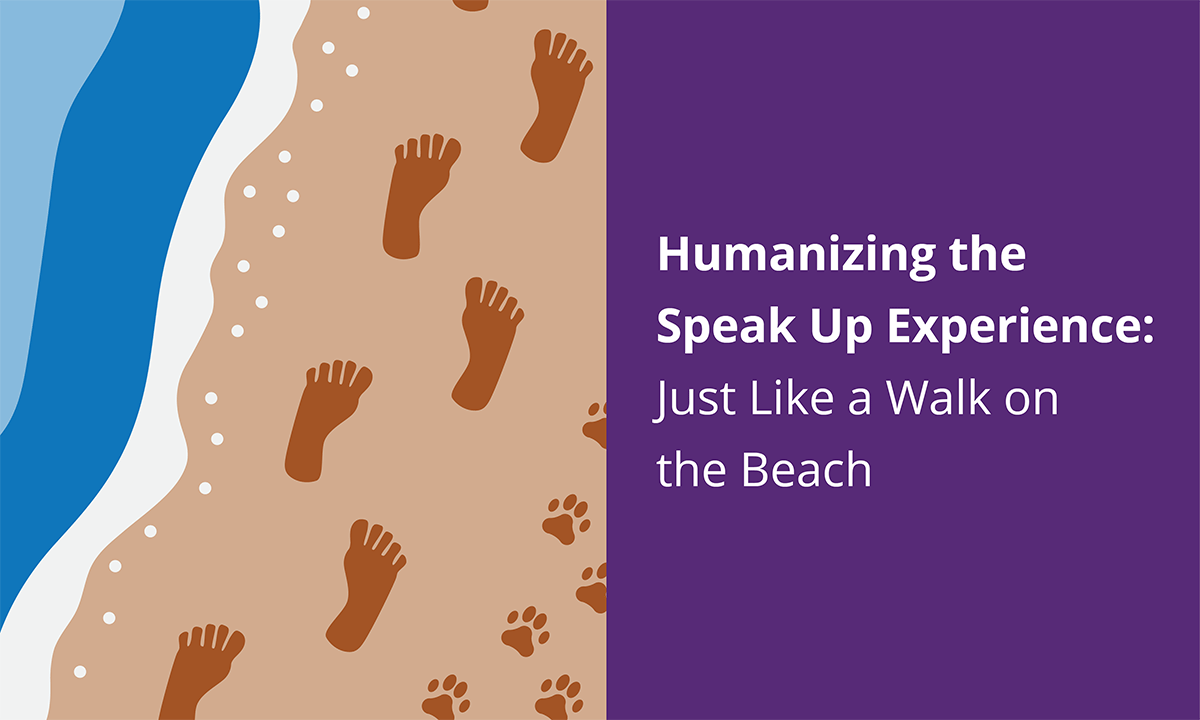
Humanizing the Speak Up Experience: Just Like a Walk on the Beach
During our summer family vacation a few months ago, I had the opportunity to enjoy my morning runs along the vast openness of the beach—but only before the sun came up; otherwise, it was much too hot and humid (Texas, y’all). Apart from the few people watching the sunrise, it felt like I had miles and miles of the beach to myself. But when I looked down, the footprints told a different story:
It was obvious that these sandy paths had been walked recently by many other people and, based on the paw prints, their dogs too. Perhaps it was the heat or fatigue, or maybe I just can’t keep my mind off of compliance, but the footprints on the empty beach made me think about the speak-up process.
Speaking up can feel like a lonely and isolating experience. People sometimes wonder if others have spoken up, if anyone cares, or if anything will be done. They may also not understand what happens once they have spoken up—leaving them feeling like they are alone on the sand. Here’s our opportunity to make a difference and make the process a little less intimidating.
Share Data: Show The Footprints of Those Who Came Before
Even if you can’t share all data about matters that are raised in your organization, you can certainly share some of it. This helps—to continue my beach analogy—show that other people have walked the path by quantifying their footprints.
Consider showing the number of reports raised over a period of time or the many different ways in which people spoke up. That’s not just your hotline, but also any direct communications to managers, HR, or the compliance team. Some other data points to consider are the types of matters people have raised, how many reports are not raised anonymously, and the days and times most people typically speak up.
Data helps normalize the speak-up process by showing your employees that many other people have also taken that path, and you have the footprints to prove it.

Pics or it didn’t happen | Source: Tomas Ferraro via Giphy
Tell Stories: Describe Others’ Paths
Data is great, but stories connect people on an emotional level. Framing data in a human and relatable way has a greater and longer-lasting impact than stats and numbers alone—even if you don’t identify anyone specifically.
Stories about someone speaking up regarding an issue that impacted them can inspire others to do the same without fear. And, speak-up stories about issues not directly impacting an employee can illustrate how doing the right thing is everyone’s responsibility. And all these stories serve to prove that stated standards and actual standards are the exact same thing.
Using stories shows that the organization cares, explains what happens when someone speaks up, and leaves a more lasting and memorable impact than data alone.
Lead Others: “Let Me Tell You About The Time I Took This Path”
There is no single metric to measure the effectiveness of an ethics and compliance program. However, the closest measurement I have come across that gives immediate insight into a program is whether leaders are regularly using their voices to talk about integrity, organizational values, and expectations. In fact, a 2018 study by the Ethics & Compliance Initiative found that “employees who agree that their managers and supervisors talk about the importance of ethics are almost 12X more likely to believe that their organization encourages them to speak up.”
A great way to normalize the speak-up process is to encourage leaders to tell stories about the times when they spoke up. When your leaders openly talk about their experiences sharing a concern, they demonstrate that they know how challenging it can be, and have the experience to support employees who come to them with an issue. Plus, it shows that speaking up does not come at the expense of professional success. Never underestimate the power of solidarity!
Side note: If leaders and managers at your organization don’t have their own speak-up stories, chances are that your organization does not truly have a speak-up culture. You might have some work to do!
Create Safety: The Kraken Doesn’t Come for Beachgoers
Ok, who DOESN’T have a policy that proclaims people “can speak up without fear of retaliation” and that the organization “does not tolerate retaliation for reporting a concern”? Can we all agree that it is time for us to re-think these policy statements and whether employees really believe them?
Instead, let’s seek to build some trust by showing employees what organizations are actually doing to prevent retaliation and what they do when it actually occurs. If we don’t back up the “no fear of retaliation” statements, we can’t expect employees to raise concerns. While the responsibility to speak up lies with every employee, the responsibility of creating a sense of safety at your organization—and, through that, a speak-up culture—lies with leaders. Leaders need to demonstrate that there is a genuine culture of care within the organization. By continuously building trust and demonstrating care for employees, we move past policy statements and into authentic commitments.
Keep Going
The speak-up experience can feel like a lonely walk on the beach, but by explaining data, sharing stories, and leading with integrity, it doesn’t have to be. Take these steps and watch your speak-up culture thrive.
About The Author
Adam Balfour is on a mission to help make ethics and compliance more relatable and relevant for his fellow human beings. He likes working in-house to design ethics and compliance programs that employees can actually find relatable, engaging and useful. He is the author of the recently released book, Ethics & Compliance For Humans (September 2023, CCI Press) available in ebook and paperback on Amazon.
-------------------------------------------------------------------------------------------------
Thank you, Adam, for your insightful and relevant blog post!
For a firsthand account of what it’s like speaking up in a workplace without a speak-up culture, check out this blog post. To “show the footprints in the sand,” snag our Speak-up Snapshot template.

